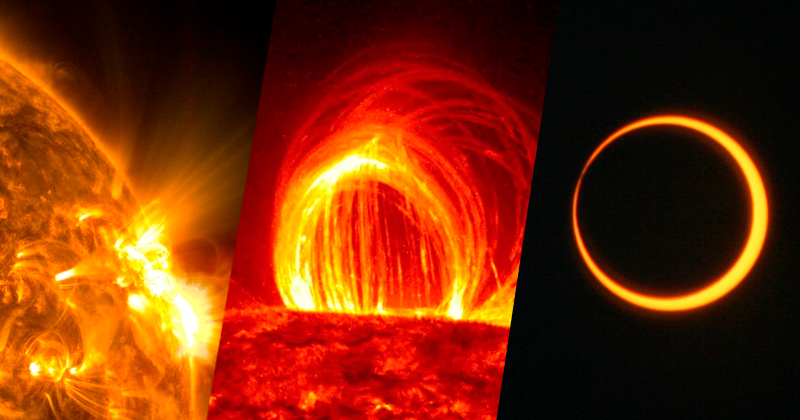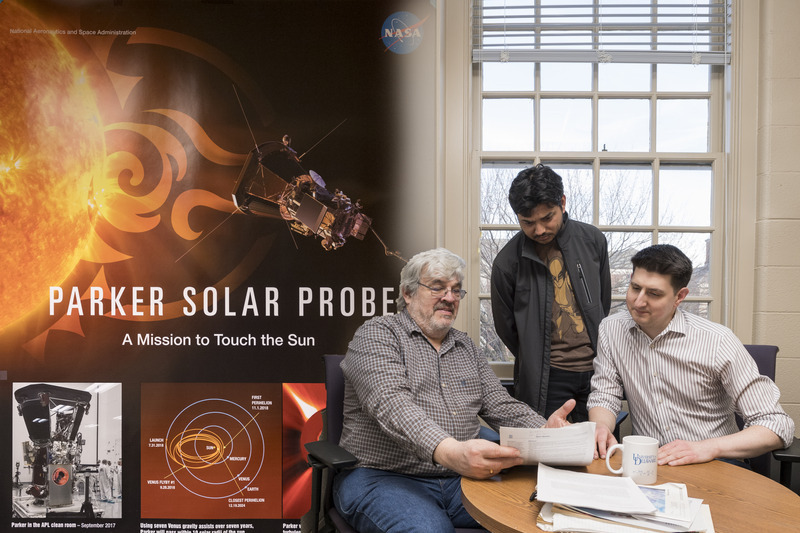


It’s showtime for the sun and its researchers
Photos by Kathy F. Atkinson and courtesy of NASA | Photo illustration by Jeffrey C. Chase October 13, 2023
NASA’s Heliophysics Big Year starts with Oct. 14 annular eclipse
It all starts Saturday, Oct. 14, with an annular solar eclipse — often called a “Ring of Fire” eclipse, because only the outer limb of the sun will be visible when the eclipse is at its fullest.
And it’s a fine way to launch what NASA is calling the Heliophysics Big Year. It will be especially great for those who live in the pathway of the eclipse — a path about 125 miles wide, running from Oregon to Texas in the United States.
Next year, on April 8, 2024, a total solar eclipse will occur on the eastern side of the nation, along a 100-mile-wide path stretching from Texas to Maine. There are several kinds of eclipses, which occur when the moon is aligned between the Earth and the sun. In Delaware, a partial eclipse will be visible Saturday, starting at about 12:03 p.m. and ending by 2:37 p.m. The peak will be at about 1:20 p.m.
But what is heliophysics and why should anyone care? Heliophysics is the study of the sun and the way its properties and atmosphere influence space and planets, including Earth. The sun provides enormous benefits to Earth. It sustains life and provides light and heat. And far too much goes on with the sun to constrain this celebration to one year. So NASA’s event actually spans 15 months, including two eclipses, the sun’s solar maximum (when sunspots are the most numerous and solar flares are more common) and the closest approach to the sun of NASA’s flagship heliophysics mission — Parker Solar Probe.
The University of Delaware has multiple physicists, including William Matthaeus, Unidel Professor of Physics and Astronomy and director of Delaware Space Grant, Professor Michael Shay and Associate Professor Bennett Maruca. They are involved in major sun-related research, including Parker Solar Probe and the Wind and Magnetospheric Multiscale (MMS) missions. They also are involved in upcoming sun-related missions such as CURIE, PUNCH and HelioSwarm.
Also on Saturday, UD’s “Eclipse Chasers” team, led by Professor Edmund Nowak, chair of UD’s Department of Physics and Astronomy, will be in Junction, Texas, for a test launch of their helium-filled weather balloon during the annular eclipse. The team is one of 70 teams participating in NASA’s Nationwide Eclipse Ballooning Project (NEBP). The team will launch its balloon again on April 8 during the total solar eclipse. Students have designed, constructed and assembled the balloon’s payload, which holds everything necessary to gather atmospheric data and what they hope will be stunning video footage.
UDaily asked UD experts for a bit of context on their research. Here are their answers:
What is the most exciting sun-related research you have been part of? What has been most surprising to you in that work?
Matthaeus: As a co-investigator on the Parker Solar Probe (PSP), I have been involved in the mission since the beginning. A main goal of PSP is to understand the origin of the solar wind, a supersonic plasma that pervades the entire solar system and establishes the neighborhood controlled by the sun. PSP is getting progressively closer to the sun with each orbit and is entering the solar corona, the region where we will likely find answers to the most important of these questions.
Right after launch (in 2018), we wrote a paper describing our theoretical explanation of how the magnetic field gets rolled up and reverses direction, in a phenomenon called "switchbacks.” We predicted that these occurrences would become less frequent and then disappear as PSP descended into the corona. So far this seems to be occurring! We hope to have conclusive evidence in the next year or so.
Maruca: Probably the most exciting work that I've done (thus far) in heliophysics has been the development of Parker Solar Probe (PSP), since it has been such a superlative mission. It recently broke its own record for the closest approach to the sun by any human-made object and the fastest speed of any human-made object (on or off Earth). PSP has become the first spacecraft to pass through the sun's atmosphere (the solar corona), which has provided us an unprecedented glimpse of the solar wind being born. PSP continues to return new data, but my students, colleagues and I are still analyzing and debating the data we already have — frankly, the community will probably be doing that for decades.

What is one of the biggest questions you expect heliophysics researchers will address in a project you are involved in now?
Matthaeus: The really big questions pertain to the dynamics inside the corona, and how dynamics inside this region account for acceleration of the supersonic solar wind. We have published a number of papers arguing that the corona is heated by a turbulence cascade, and then the elevated pressure drives fast solar wind. The theory seems to work. PSP and another mission we are involved in — called HelioSwarm — will further our understanding of solar wind turbulence. If all goes well, these missions will decide whether the turbulence is responsible for the crucial features of the entire heliosphere.
Maruca: One big question that many people in the field (including I) have been working on for a while now is what exactly happens to the solar wind as it expands outward from the solar corona, past Earth, and out to the outer solar system. For a while, I think many early researchers had assumed that all of the action took place in the solar corona and that everything that followed was the simple expansion of a gas. To some extent, that's true — most of the solar wind's heating and acceleration take place in the solar corona — but there's far more to the story. This year, colleagues and I published the results of the Trans-Heliospheric Survey, which used archived data from 12 spacecraft to piece together the solar wind's journey. We found that, on average, the solar wind's speed steadily increases through much of the inner solar system and doesn't really level off until about the orbit of Venus. That means that while the solar wind is "born" in the sun's atmosphere, it really doesn't reach "adulthood" until it's most of the way to Earth.
We all take the sun for granted, but it is certainly a lifeline for us and all of Planet Earth. Is it OK? Will it be there for a good long while? And is there even a way to know this?
Matthaeus: Everything we know about solar physics and stellar structure indicates that the sun is a very normal (and healthy) star that will be around for another billion years or so.
Maruca: As far as we know, the sun seems to be a remarkably stable star — at least over the timescales of human lives/civilizations and certainly in comparison to many other stars which show much stronger variability. The sun does alternate between periods of high and low activities — "solar maximum" and "solar minimum" — with a cycle taking about 11 years. The most obvious manifestation of solar activity is sunspots, which are associated with solar flares (dark spots on the surface) and coronal mass ejections (CMEs, which are large bursts of extra solar-wind material). The sunspot record goes back about 400 years to the development of the first telescopes. Though there's some variability in terms of the duration of each cycle and the strength/depth of each solar maximum/minimum, the pattern is very consistent through the centuries. Longer-term histories of the sun's activity can be pieced together with ice cores, since solar activity can affect the abundance of element isotopes (e.g., carbon-14, which is used in dating artifacts). These reveal some trends in solar activity over millennia, but I don't think that anyone has found any indications of sudden or dramatic changes.
This year, we can “just look up” and see some cool things in the sky with the annular and total eclipses in October and next April. Is there anything else you are especially looking forward to this year? Is there anything you would suggest people keep an eye on — or a backyard telescope on — during this next year?
Matthaeus: Keep an eye on news about PSP! You won’t see it in a telescope, but there will be news of research based on every orbit. Of course when you see images of the corona based on the eclipses, you will be seeing the very structure that PSP is passing through and measuring!
Maruca: 2024 will also have two lunar eclipses: one in March and the other in September. Though both will be partial, they both will be visible from Delaware. Though a lunar eclipse is not nearly as dramatic as a total solar eclipse, I've still always enjoyed seeing the moon pass into the Earth's shadow. Especially during a total lunar eclipse, the moon often takes on some dazzling colors.
Watching the annular eclipse
Watching the annular eclipse won’t be a dramatic experience from Delaware, especially if the sky is cloudy or rainy. We will see the moon obscure only about 20% of the sun’s surface, but you can watch broadcasts with the best views online. NASA will have live coverage on its YouTube channel, for example. NASA also has expansive information about eclipses and how and why they happen. It also offers good maps of the path and timing of the eclipse, along with guidance about how to protect your eyes from the damage caused by looking directly at the sun. Never look directly at the sun without protective eclipse or solar glasses — whether an eclipse is occurring or not. The sun always produces far more light than the human eye can handle. Permanent eye damage (including blindness) can result. Damage is even more likely when using binoculars or telescopes, which collect and concentrate light.
Contact Us
Have a UDaily story idea?
Contact us at ocm@udel.edu
Members of the press
Contact us at 302-831-NEWS or visit the Media Relations website

